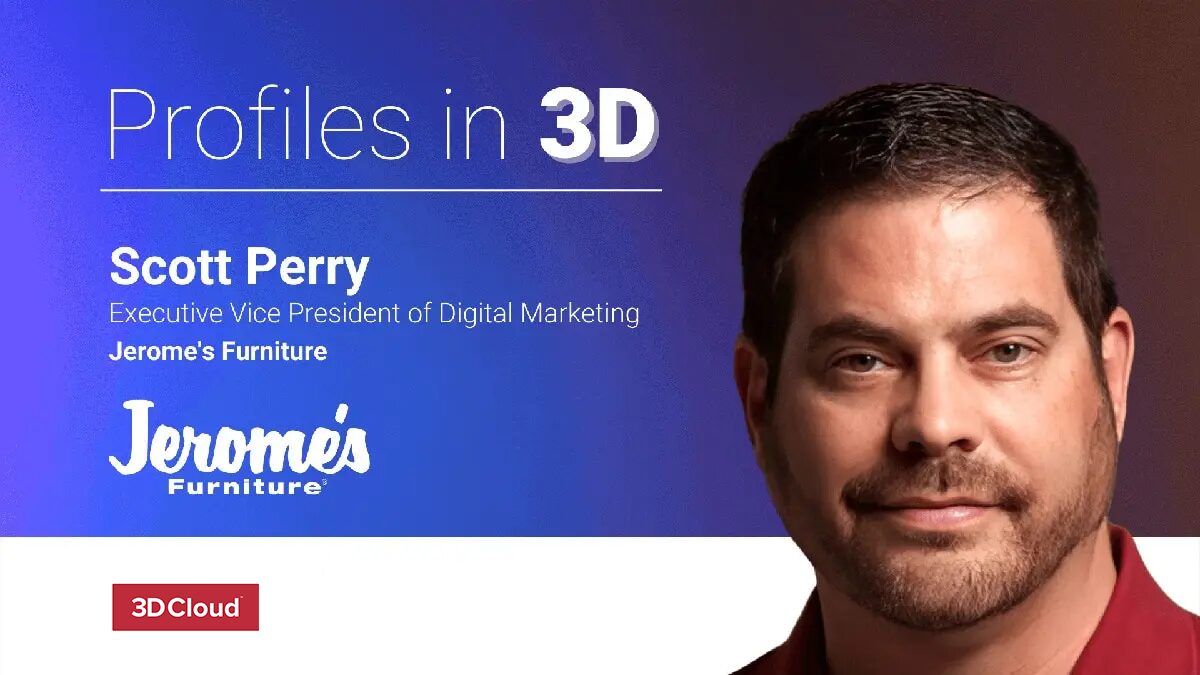
About Scott Perry, 3D Pioneer
Scott Perry is a digital home goods pioneer credited with the first launch of Augmented Reality in retail. And while Jeff Bezos was bringing books online, Scott was among the first intrepid souls launching e-commerce for furniture way back in 1995. Today Scott is the EVP of Digital at Jerome’s Furniture in San Diego, California. He has also served as VP, Executive Director of Omnichannel at Bob’s Discount Furniture and was an early advocate for AR as a remote furniture sales strategy. Scott has partnered with 3D Cloud to deploy 3D multiple applications at both Bob’s Discount Furniture and Jerome’s Furniture and is an active contributor to 3D Cloud’s 3D application roadmap.
Included in this interview:
- Can you tell me a little bit about your background?
- How did you get involved with Augmented Reality?
- What was the original Jerome’s AR experience like?
- If you were starting from scratch today, where would you begin?
- How do you know that AR is working; how do you communicate performance to the executive team?
- 3D Cloud data shows that big, high-cost items such as sofas and beds are most frequently viewed in AR. Do you see the same thing at Jerome’s
- With regard to AR, we often get the question ”Do I publish to both app stores, or just stick with Apple?” What’s your take on this?
- Are apps still relevant? We have a lot of potential clients that say, “I don’t want to do an app, I want to do Web AR. I think apps are irrelevant.”
- What are some of the advantages of having an AR app vs. Web AR?
- And if the customer deletes the app after they use it?
- What is your average order value (AOV) with AR and 3D apps?
- Is file format standardization coming? How do you make sure that your content investment isn’t wasted?
- Pinterest is publicly traded. 96 percent of searches are unbranded. Something like 90 percent of online furniture shoppers start there. How are you thinking about the world of inspiration as taking over the starting point for consumers?
- How many people do you need to hire to take on a 3D initiative? How many people do you need?
- How do you stay informed about developments in AR and 3D – where do you get your information?
Can you tell me a little bit about your background?
In 1995, I launched two online furniture companies – FurnitureOnline.com and OfficeFurniture.com. Over the following decades, I was involved in multiple online furniture ventures. Then, in 2013, I decided that the future of the furniture business was omnichannel. Online only furniture retailers, including Wayfair, were stuck with transaction size that was a small fraction of a typical in-store transaction. Wayfair had an average basket of $247 and most furniture retailers have much higher in-store transaction values. Multiples higher. This inspired me to figure out how to bring digital experiences into brick and mortar stores and create more connected digital experiences. The CEO of Jerome’s Furniture bought into my vision and so that’s where I decided to start my omnichannel adventure.
How did you first become interested in Augmented Reality?
I wanted AR to be a thing before it was a thing. In 2013, I had the idea to deploy an experience like AR but the technology wasn’t quite there yet on either the hardware and software sides of things. At the time, the iPhone 5 was the smartphone of choice and even their software wasn’t ready for AR. Ikea had started testing AR and ran a campaign, but it was super clunky and fizzled out. In 2014 I found an AR startup out of Tel Aviv, Israel that was doing some work for Coca-Cola with AR product placement for vending machines. I asked if they could make it work for furniture, they said yes and we spent the next year figuring it out together. In 2015 we launched the first AR app for a regional furniture retailer in the US.
What was the original Jerome’s AR experience like?
For the time, it was great and we had good success. We used it in marketing materials and TV commercials. One day we had a customer walk into a store while that I was in. I saw her put a bunch of paint chips from Home Depot in the background. Then she put a fabric sample down and held a printed out picture of her living room and stood back trying to picture what it would all look like together. I approached her and showed her the AR app and her jaw hit the floor. She said, “Is that for real??!” At that moment I knew that we were solving a major customer problem with AR. The fundamental question, “what will it look like in my home?”
If you were starting from scratch with Augmented Reality or other 3D apps today, where would you begin?
I would start with an AR app but before starting with AR, you need to have the e-commerce bases covered. That’s the fundamental you need in place, start with an excellent online experience. That said, 3D is here and if you aren’t already using 3D, your competition is. You have to do it. It’s not really a choice. Customers are having 3D experiences across the board. Warby Parker to try on glasses, Sephora, and Ulta to try on makeup, and Facebook’s Oculus products for VR gaming. Customers expect it, so if you’re starting from scratch then you are already behind. Besides the competitive nature, it solves the problem: What’s it going to look like in my house. It leads to increased customer satisfaction, fewer returns, and creates engagement with your brand.
How do you know that AR is working; how do you communicate performance to the executive team?
We track customers that visit our mobile website through the AR app, We look at the conversion rate for those customers who use the app on mobile vs. mobile web and can track the behavior of people who engage with AR and see their transactions. The lift that we get is an over 100% percent increase in conversion rate for app users vs typical web users. People who use the AR feature convert a whopping 250% more than typical website users. We also know that it drives people to the store. Our customers commonly mention the AR experience to our in-store sales staff. We aren’t measuring yet, but we know that it is driving customers to the store.
We just did a roundup of all the 2020 metrics for AR. Sofas, sectionals, dining room sets, and beds – physically big and high-cost items – are the most frequently viewed in AR. Do you see the same thing at Jerome’s?
We see that. It’s not just will it fit, it’s also, will it block a window or keep my door from closing. Our stats are similar in nature to the ones in the infographic. People 55 and overall the holdouts who have been forced to use tech. That is our highest growth conversion rate demographic. Not shocked to learn that it’s largely women and iOS
With regard to AR, we often get the question ”Do I publish to both app stores, or just stick with Apple?” What’s your take on this?
You have to publish to both app stores as well as Web AR or you get customer backlash. You can’t leave 20-25 percent of customers with the question: When are you going to take care of people like me? You have to be there for all the customers, period.
Are apps still relevant? We have a lot of potential clients that say, “I don’t want to do an app, I want to do Web AR. I think apps are irrelevant.”
I think you have to give both to the customer. The reality is that the customer is more empowered more than ever. You can’t force them to download an app but there are a lot of advantages to having the app. You need to be able to provide a similar experience to people who don’t want to download an app for whatever reason.
What are some of the advantages of having an AR app vs. Web AR?
You can do other things that you can’t do without an app – like a QR code scanner, push notifications. I need the app to enable omnichannel experiences. We are about to add QR codes to every single tag so that a customer can download the app, scan QR codes and have in-store multimedia experiences. When you have an app you have screen real estate on someone’s phone. Some people uninstall, some don’t. E.g., Zillow. I downloaded it for a purpose but left it on my screen for years.
And if the customer deletes the app after they use it?
Not a bad thing for the app to be deleted. If they complete a journey they may delete it and that’s ok too. We have strategies to keep the app engaging. We send a deep link push notification for an AR experience every Saturday, some entertainment, some value on a regular basis. Keeps people engaged with the brand.
What is the average order value (AOV) with AR? We are starting to talk about room planning, room commerce, adding a full room to cart – the idea of someone buying 4k or 5k of furniture online without ever coming into a store. Is that really happening?
Our average order value online is pretty high. I’m surprised. Well over 1k. I’m surprised at it. Some of the AI and ML recommendations that we’ve been able to put on the site to help build the ticket. But getting average ticket size at $2k – $5k online – we see it now and it’s going to continue to grow especially if there is a good 3D room planning experience.
People are worried about file formats, fear of investing in the wrong type of content. How do you make sure that your content investment isn’t wasted?
Even the smartest companies can’t know everything. There are always unknowns. File format standardization is coming. It’s the same thing with image file formats. New image file formats come out – you have to roll with it and figure it out as you go. By working with 3D Cloud and their cloud 3D solution, we feel a bit of insulation against that because their cloud can adapt to present various file formats as things settle into more standardized formats and evolve.
Pinterest is publicly traded. 96 percent of searches are unbranded. Something like 90 percent of online furniture shoppers start there. How are you thinking about the world of inspiration as taking over the starting point for consumers?
How do we create a Pinterest-like experience on our website to fill that inspiration and “idea need” that the customer seeks early on in their shopping journey? We want to be a place to get ideas – browse through customer photos, video library, shop the look, and really take a deep dive into trends and inspirational content. We think about it all the time. When you create experiences for customers, people remember you and have a subconscious commitment to your brand. Plus you become a destination for ideas and inspiration, not just a place to buy stuff. It adds value to the customer and attracts potential customers as well.
How many people do you need to hire to take on a 3D initiative?
You don’t really need to hire someone. You could but it’s not a full-time job. You already have someone in charge of content and product photography already. Once we got up and running at Bob’s (and Jerome’s), I dedicated part of a content team member to ensure that models were consistent and communicating with merchandising on content orders. You do need someone who owns that responsibility. It wasn’t really time-consuming but it does need to be assigned. A part of a person – an added responsibility to an existing team member. To ensure that we have the content that we need.
We have nearly 10 years of experience with 3D at this point. But it looks like AR is finally starting to move into a general adoption phase. How do you stay on top of it, how do you get your information and stay current and head of the competition?
I look at other retailers, what they are doing, how they are adopting things. I was a regular attendee at Shoptalk and eTail. Watching closely what the industry is doing, outside of furniture – for instance in the beauty category, Go outside of furniture. Follow LinkedIn groups on 3d AR VR, keep an eye on what Apple is doing with their glasses tech. I personally buy my own VR tech and use the tech myself – download and play with the latest AR apps no matter what the content is. I just make sure that I’m in the know as much as possible.
With more and more retailers outside of furniture adopting the tech, there is a massive opportunity for apparel if model costs get low enough – virtual try-on, when you can virtually wear things. The frequency of purchase is much higher. My guess is that Amazon might solve that. I keep a pulse on what’s going on. If there is a new AR app out there, it’s on my phone. Or I talk to Beck or other folks at 3D Cloud.
I’ve got 99 problems but 3D is not one of them.











